Where do hairless cats originally come from? How should you care for a hairless cat? Do hairless cats
need special care? Which breeds are considered to be hairless cats?
When it comes to hairless cats, the overall opinion is usually quite divided. People are either totally beguiled or utterly repelled by them. Indeed, the unusual appearance of hairless cats tends to polarise cat lovers. Why do some of us love them so much? Is it possible that their almost hairless skin – that whimsical quirk of nature – is something we humans adore because we consider anything outside the norm to be special and maybe even lucrative? And how well do hairless cats deal with their status as “special” cats?
Do hairless cats have any special needs? Are hairless cats suitable pets for allergy sufferers who
otherwise wouldn’t be able to have a cat in their home?
Hairless cats
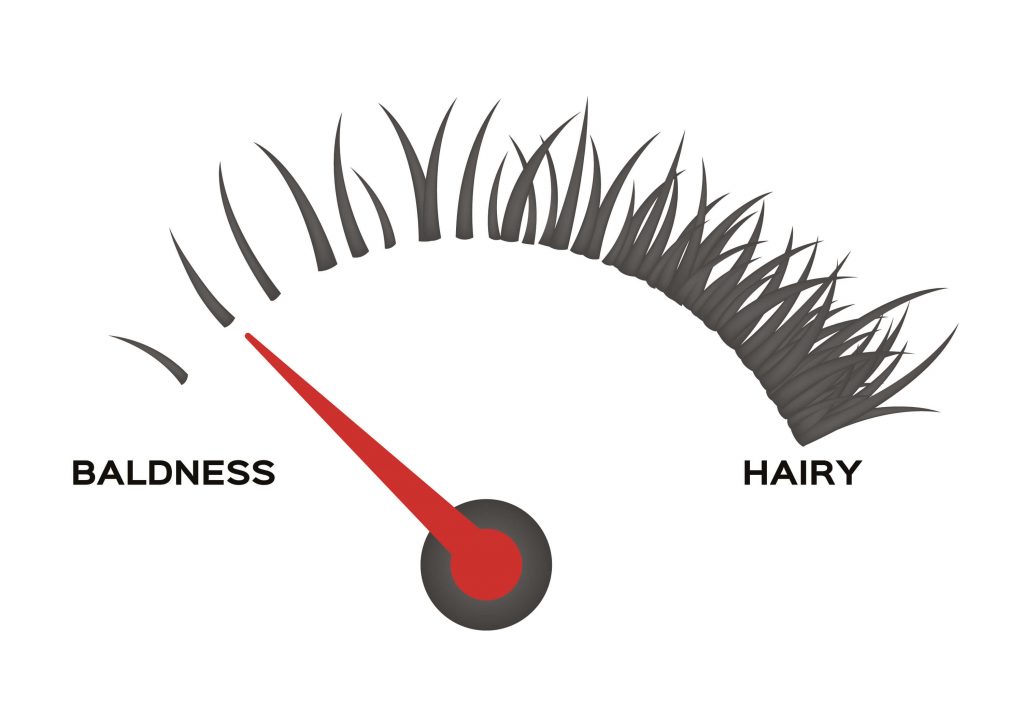
Cats with no fur on their bodies are referred to as “hairless”. However, even though they might look completely hairless, they usually still have a layer of delicate peach fuzz covering their body. One hairless breed is known as the Peterbald and although these cats literally have the word “bald” in their name, it doesn’t automatically mean they’re always hairless. In fact, Peterbalds can have 5 different coat types: no coat, almost no coat, a rough coat, a light coat or a short coat. It all depends on whether or not the cat is carrying the recessive gene responsible for causing the lack of fur. Only when both parents carry this gene will hairless Peterbald kittens be born.
The appearance of hairless cats
A hairless cat’s appearance is deceptive on a number of different levels. Their medium-length body with its deep chest and rounded belly is actually stockier than you might think! In other words, when you pick up a hairless cat, you’ll likely be surprised at how heavy they are. They have a wedge-shaped head that’s longer than it is wide, and their nose extends the wedge-shape of the head even further. They have a prominent chin that’s slightly rounded, their ears are very large and wider at the base, and their eyes are slanted and shaped like large lemons. A hairless cat’s skin is wrinkled, especially on the head, and feels velvety and warm to the touch.
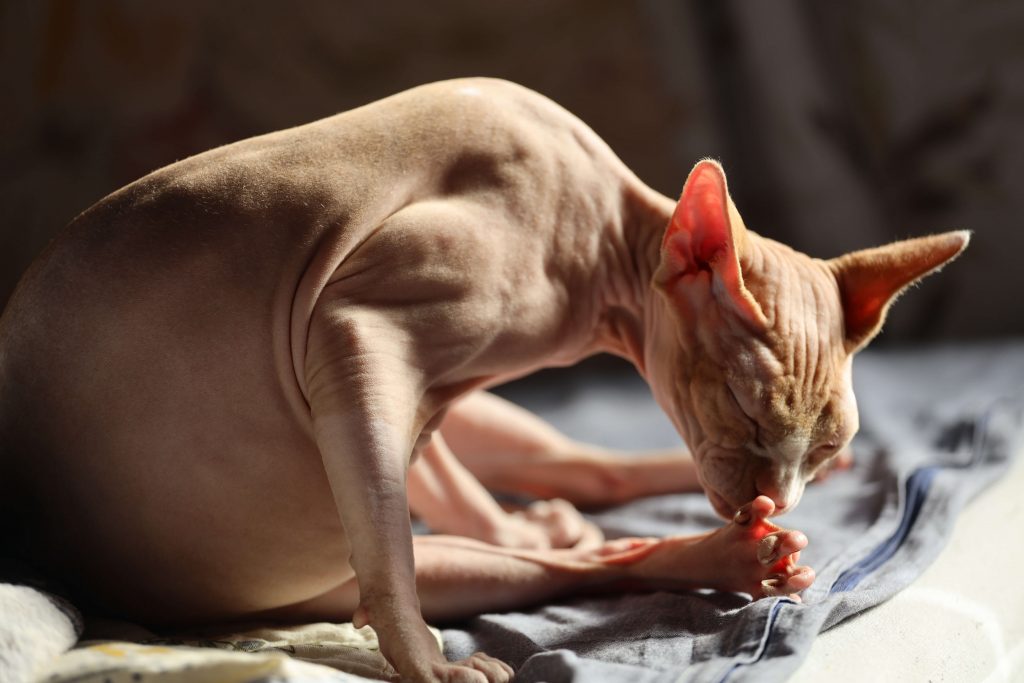
The origins of hairless cats
Some of the most well-known hairless cats are the Bambino, the Canadian Sphynx, the Elf Cat, the Don Sphynx, the Kohana, the Peterbald and the Ukrainian Levkoy. Although each of these breeds belongs to the “hairless cat” genus, they’re actually not related to one another. They each have different origins, come from different countries and were not bred at the same time. Still, all hairless cats have one thing in common: they share a genetic mutation – one that reflects mother nature’s whimsical side – that’s become a key characteristic of their breed.
Are hairless cats a so-called “Qualzucht” or “torture breed”?
The German Animal Welfare Act defines the practice of Qualzucht¹ as the breeding of animals in a way that fosters or tolerates characteristics that cause them pain, suffering, damage and/or disorders in their offspring. When hairless cats don’t have any fur or whiskers it means they’re inevitably going to be restricted in several ways. First of all, cat whiskers are little miracles of nature; these bristle hairs – also known as vibrissae, sinus hairs, sensory hairs or tactile hairs – are a highly specialised form of hair. They’re not part of your cat’s actual coat of fur; instead, they’re part of a sensory organ the cat uses to feel, sense and touch. Without whiskers, cats wouldn’t be able to do the things they’re best at, namely lurking, hunting and communicating. Wait, do cats actually communicate? Indeed, our kitties use these sturdy bristles to communicate with us, and we can even read their mood by looking at their whiskers!
¹Source: Deutscher Tierschutzbund e.V. (2024): “Französische Bulldogen, Nacktkatzen und Co., Qualzucht bedeutet lebenslanges Leid für Tiere”, online at Qualzucht – Deutscher Tierschutzbund e.V., accessed on 1 March 2024
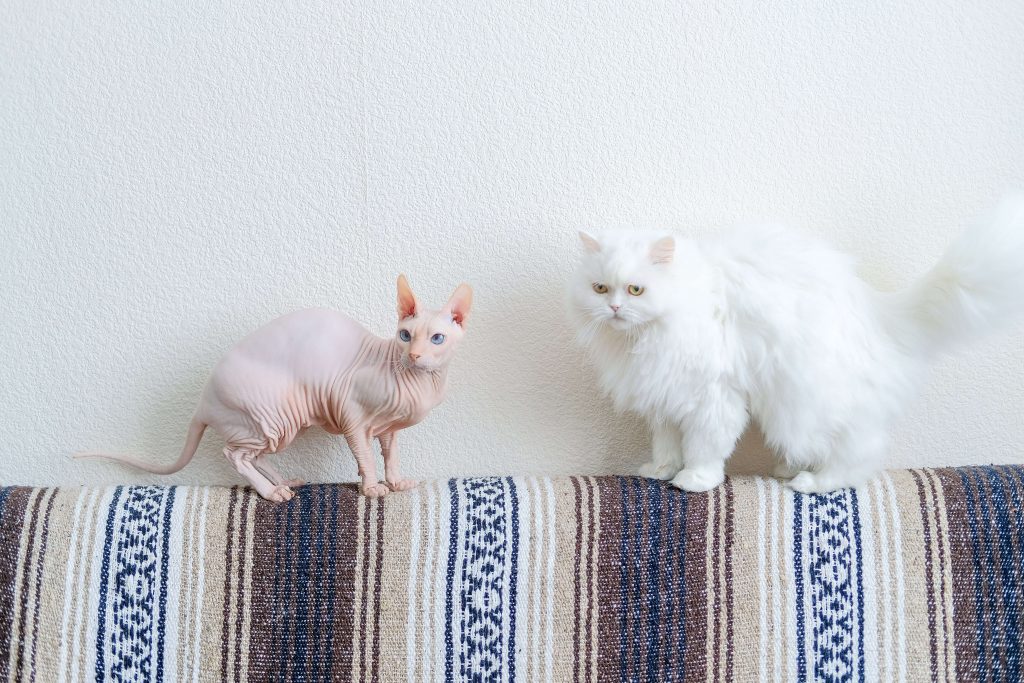
What’s the best way to care for hairless cats?
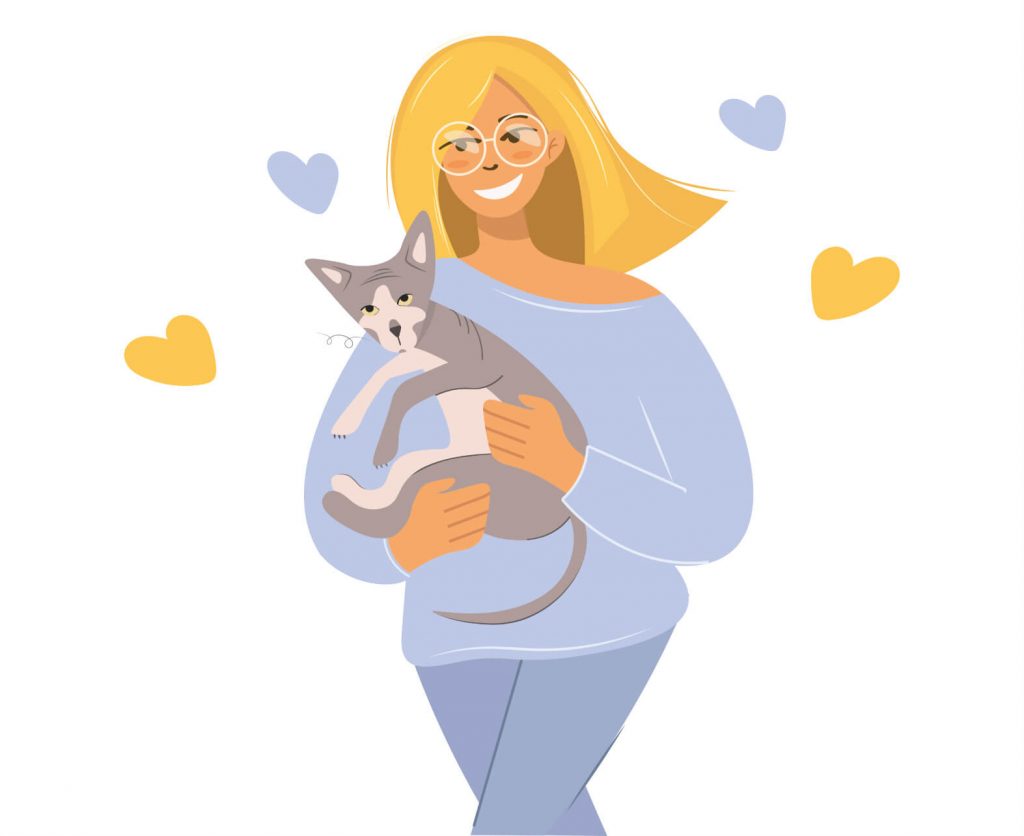
When a cat is hairless or has very little fur on their body, does it mean their owners won’t have to groom them at all? Not quite! While it’s true that the daily brushing sessions you carry out with furred cats won’t be necessary, a hairless cat will still need a little help when it comes to skin care. Why? Because the skin of hairless cats produces an oily substance called sebum. When furred cats have excess sebum on their skin, it’s usually absorbed by the cat’s hair. As hairless cats have little or no hair, what usually happens after a while is that a film of oil forms on their skin, and this can clog their pores. In order to avoid developing any skin problems, it’s therefore necessary to care for the skin of hairless cats.
Should you wash hairless cats?
“Water is for washing, – falleri and fallera” sang the Three Peheiros in the 50s. Unfortunately, most cats aren’t huge fans of water, which means they likely won’t show much enthusiasm for any of the bathing rituals we humans love. Still, many hairless cats will actually be quite happy to be bathed! But is it absolutely necessary to wash a hairless cat to remove excess sebum? The answer to that question depends on the cat: Does it tend to have oily skin? Some cats will develop more of an oily film on their skin than others. If only a small amount of oil has accumulated on their skin, it’s enough to clean it off with a warm and slightly moist microfiber cloth
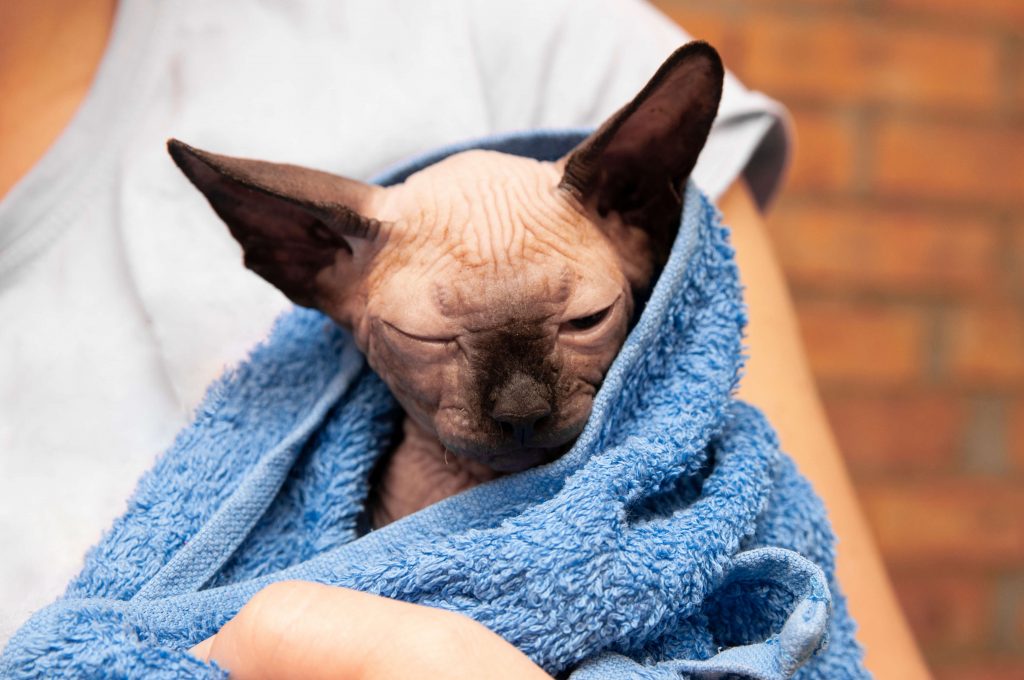
How often should you wash a hairless cat?
In order to prevent skin problems, hairless cats should be washed twice a month. If your hairless cat comes directly from a breeder, it’s possible that the cat will already be used to being bathed. However, if your cat has never had a bath before and you intend to bathe it for the first time, you’re going to need a plan. In fact, you’re going to need a
sophisticated strategy that leaves nothing to chance – and maybe even makes it possible for your cat to actually enjoy the experience.
TIP: If you want to bathe your cat, you should proceed strategically!
1. Secure the area:
- Close all windows and doors (close the bathroom door only after your cat is
in the room, of course)
- Put anything out of reach that your cat could accidentally break
- If it’s winter, turn up the heat a bit so that it’s warm enough
2. Prepare for the washing:
- Get your washing equipment ready (shampoo, washcloths, towels, thermometer)
- Pour some warm water (maximum 15 cm at roughly 35 degrees Celsius) into a big basin or tub
- Put some sort of splash guard or drip protection, such as towels, on the floor and around the basin or tub
If possible, call in some reinforcements: one person can do the washing while the other distracts the cat.
This kind of teamwork will give you a real chance of getting through the bathing procedure unscathed.
Which shampoo is best for hairless cats?
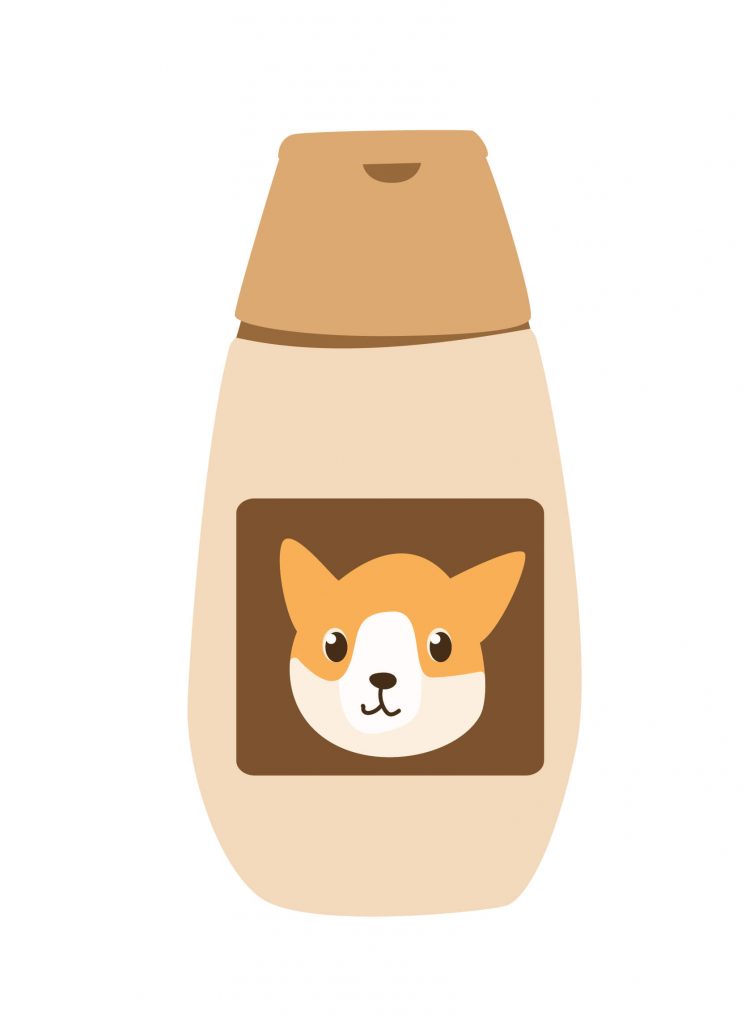
When washing or bathing your hairless cat, you should only use a mild, pH-neutral shampoo. Immediately after
bathing, you should dry your kitty off carefully to prevent them from catching a cold. Feel free to ask your vet beforehand to recommend a shampoo suitable for hairless cats
NOTE:
It’s better to avoid applying oils or creams to the bodies of hairless cats, as their skin will generally remain supple even without additional moisture. Oils and creams will attract dirt and can sometimes clog the pores of your cat’s skin.
Things to know about caring for hairless cats
What are the things your hairless cat needs in order to have a great life? First of all, a hairless cat needs lots of attention and affection. These are intelligent and lively cats, so they’re going to want to play a lot and let off steam. It’s a good idea to offer them a variety of cool toys and plenty of room to exercise and run around in. With a little imagination, you can even make small areas bigger by creating opportunities for climbing, running and chilling on the walls of your home. It’s also a great idea to offer them several different sleeping areas: they’ll love cuddly nests and bunks at all different heights.
Caring for hairless cats in summer
Are there any guidelines on how to care for hairless cats in the summertime? Yes! First of all, during the warm summer months, your hairless cat should not be exposed to direct sunlight without some kind of protection. When temperatures rise, hairless cats will also need more fluids than usual. So always make sure they get enough to drink. In view of those hot summer temperatures, it’s also important to clean up any soiled areas as soon as possible after your cat uses their toilet and keep the litter box clean. This will ensure that your cat’s litter box remains hygienically fresh even in summer.
Caring for hairless cats in winter
Is there anything you should keep in mind when caring for a hairless cat in wintertime? During the winter months, it’s usually snowy and freezing outside, but toasty warm inside. At this time of year, hairless cats without a thick coat of fur will be more sensitive to the cold than their furred counterparts. Make sure your hairless cat spends their days and nights in well-heated living spaces, and always avoid draughts! Don’t forget to make sure that all windows
and doors are secure.
NUTRITION:
Hairless cats have to expend more energy to maintain their body temperature.
This means they’re going to need a diet that has more protein and fewer carbohydrates.
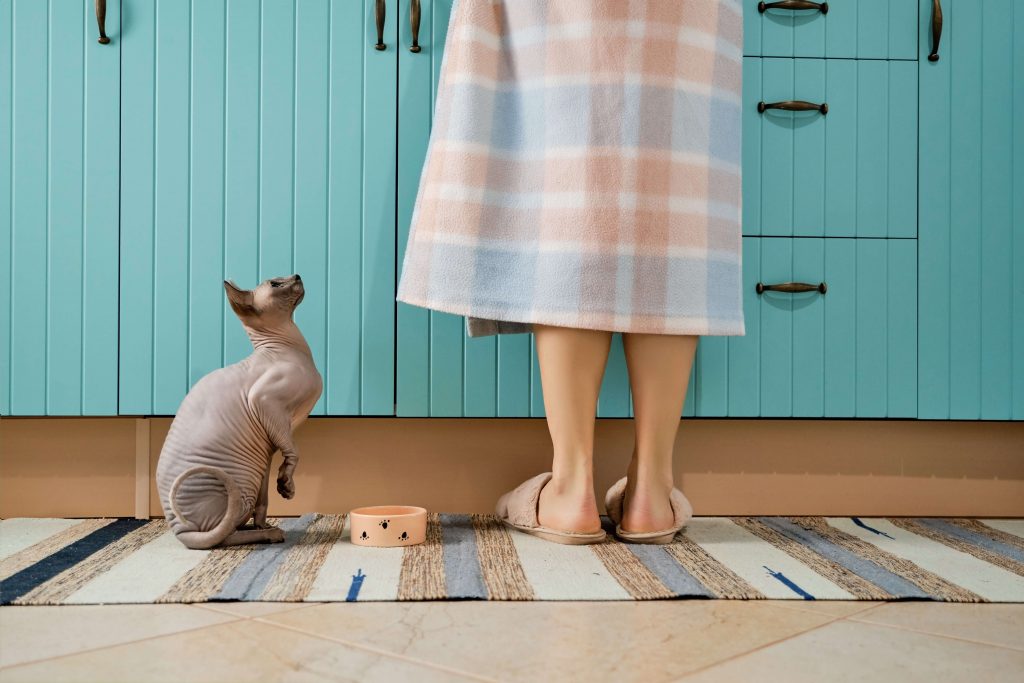
Cat breeds with no fur
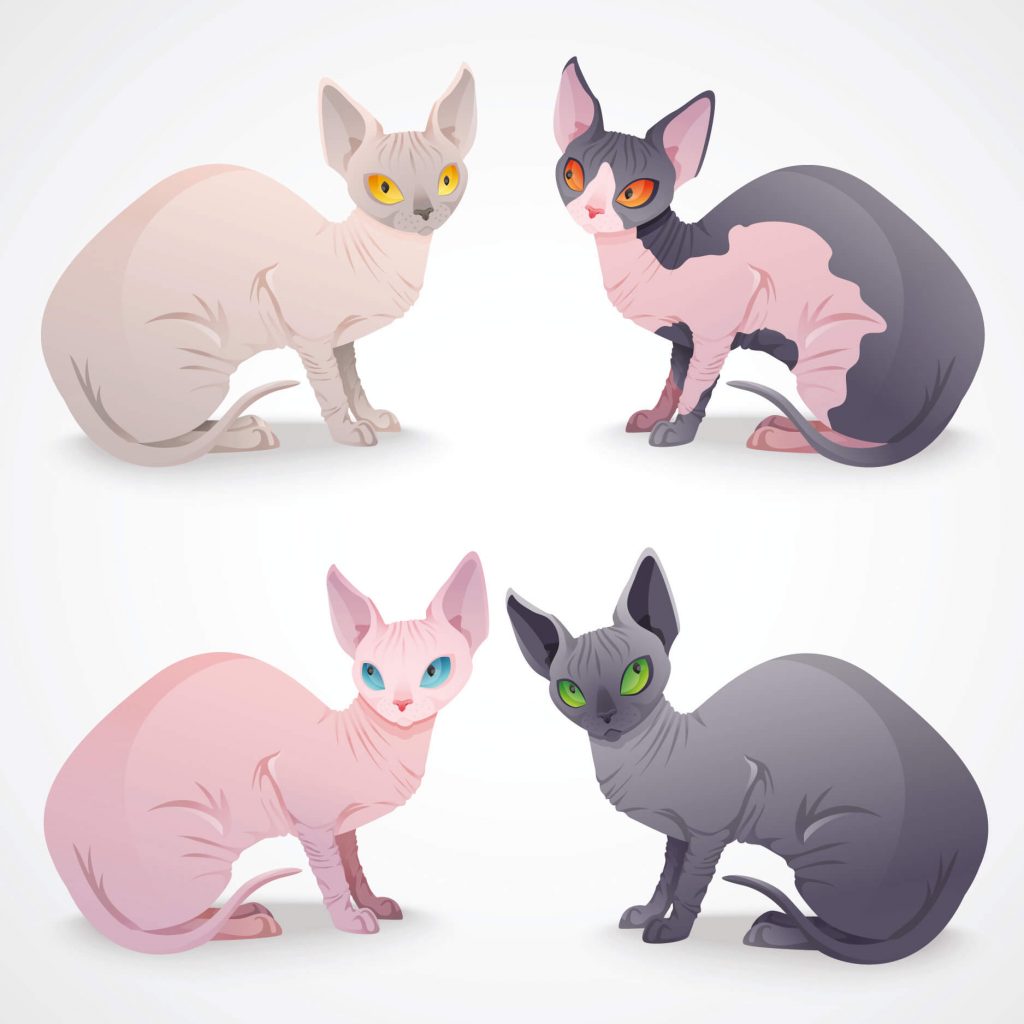
Cat breeds with no fur belong to the group of so-called hairless cats. Strictly speaking, however, these cats aren’t
hairless at all, at least if we take hairless to mean without fur. If you look closely, you’ll notice their bodies are covered with very fine and delicate peach fuzz. When hairless cats grow up, it’s possible that these hairs
will gradually disappear, although sometimes a few hairs will remain on the body, usually on the head, paws and tail. And now we’d like to introduce you to the Bambino, the Canadian Sphynx, the Elf Cat, the Don Sphynx,
the Kohana, the Peterbald and the Ukrainian Levkoy:
Bambino cat
The Bambino is reminiscent of a Munchkin, and that’s no accident! The Munchkin is a medium-sized cat with straight, muscular legs that are noticeably very short. According to the breed standard, Munchkin cats have a short to semi-long coat. Their short legs are the result of a dominant gene. If a cat mates with a Munchkin cat, the result will be Munchkin kittens with mutated, extremely short legs in the first generation. The Bambino cat was created by mating a Sphynx with a Munchkin: the result was a hairless cat with short legs.
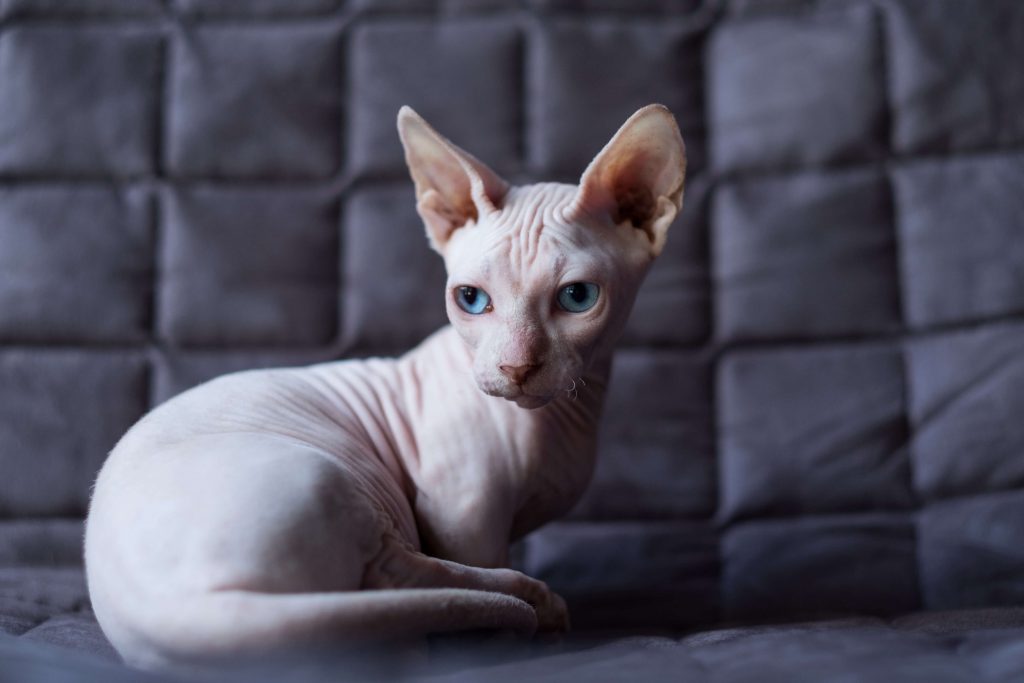
Canadian Sphynx
Sphynx cats are the most well-known hairless cats in the world – and also among the most expensive. You’re going to have to dig a little deeper into your pocket to purchase a pedigree cat like the Sphynx. In the late 1970s, a cat lover in Toronto found two stray hairless cats and quickly named them “Paloma” and “Punkie”. These two females were then mated with a Sphynx male in the Netherlands. Alongside the furry “Jezebel”, these two are considered the progenitors of the Canadian Sphynx. “Paloma” and “Punkie” are also responsible for the breeding of the Sphynx lines in Europe.
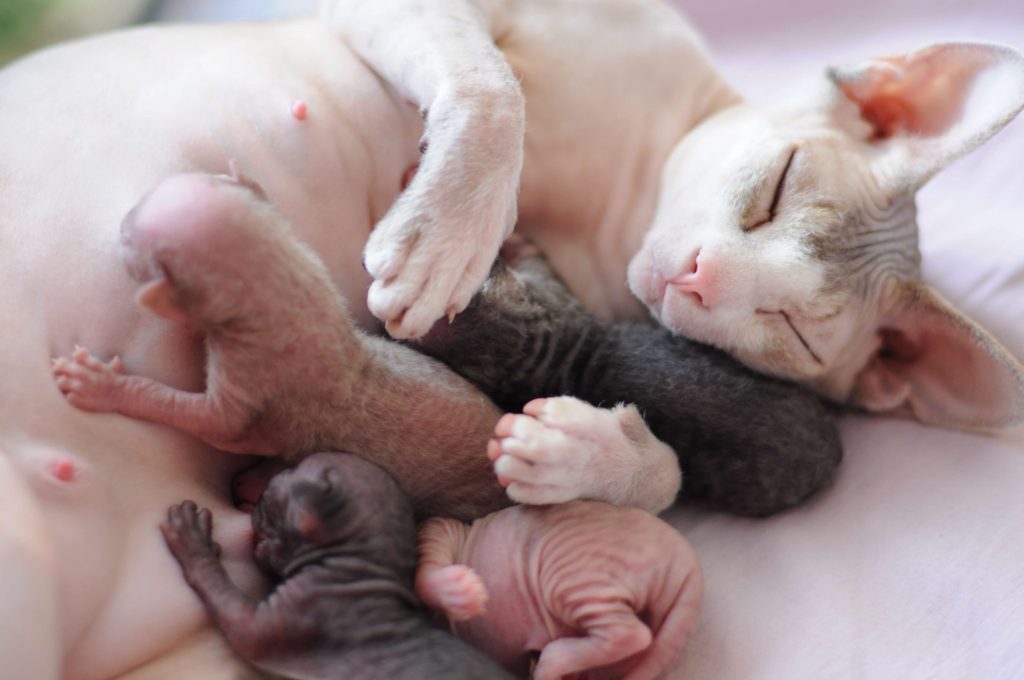
Elf cat
When you look at an Elf cat, you’ll probably be reminded of an American Curl! Why? Both of these pedigree cats have a striking feature in common that’ll immediately catch your eye: those unmistakeable curled ears! Their ears
stand upright on the edge of their head, with the tips curved slightly backwards and pointing towards the middle of the head. When Elf kittens are born, their ears are not yet curved; only over time, as the kittens grow older,
do their ears start to curl. The Elf cat is a mixture of the Canadian Sphynx and the American Curl; it is hairless and has signature curled ears.
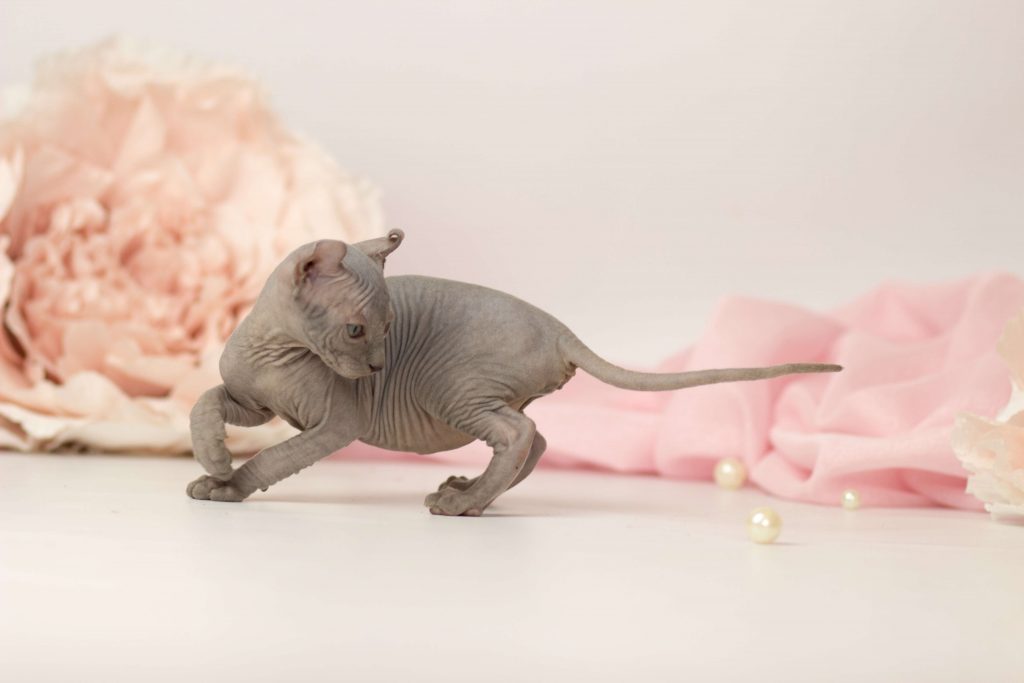
Don Sphynx
The Don Sphynx is also known as the Don Hairless or Donskoy. Although the Canadian Sphynx and the Don Sphynx both have “Sphynx” in their name, the two cats are not related by blood or by marriage. The Canadian Sphynx comes from North America and the Don Sphynx from Russia. In addition to that difference, the gene that causes their hair loss is even more dissimilar than their countries of origin: the Canadian Sphynx has a recessive gene, while the Russian Sphynx has a dominant gene. A recessive gene is not necessarily noticeable, but as the name suggests, a dominant gene always expresses itself.
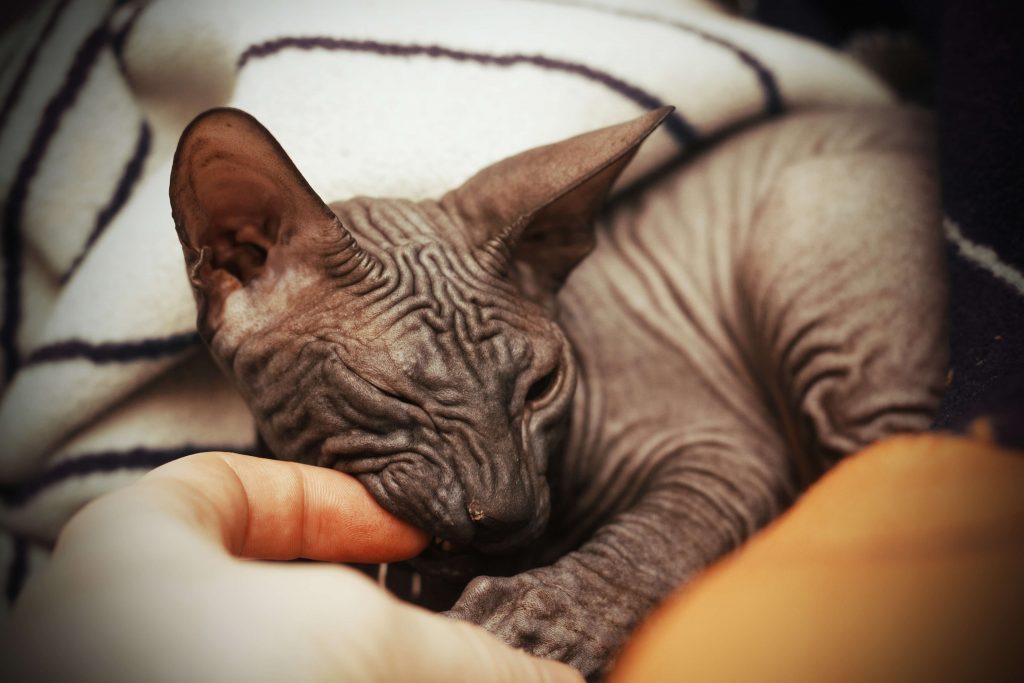
Kohona cat
The Kohana cat is completely hairless. They have no fur, not even a single hair. The Kohana cat² is not a recognised breed and there are many myths surrounding their origin. Still, there is agreement on one point: the Kohana is considered to be the ugliest cat breed on the planet. It’s a sad claim to fame. These cats have no tactile or whisker hairs and since these hairs constitute an essential sensory organ for cats, the breeding of such cats is considered
animal cruelty (“Qualzucht”) and thus prohibited in Germany in accordance with the German Animal Welfare Act (TierSchG §11b).
²Quelle: Zwei haarlose Kohana-Katzen berühren ihre Nasen und schauen sich um, [YouTube-Video.], National Geographic Creative, Science Of Cats – YouTube , accessed on 6 March 2024
Peterbald
Peterbald cats look like shorthaired Oriental and Javanese cats. Just like those breeds, the Peterbald has a long and slender body. Despite their elegant appearance, these deep-chested medium-sized cats are stockier than you might think. With its typical contours, the Peterbald’s wedge-shaped head is longer than it is wide, and their straight nose serves to extend the wedge shape of the head. The Peterbald muzzle and chin are slightly rounded, and their large ears are particularly wide at the base. The beautiful almond-shaped eyes of the Peterbald will shine at you in intense aquamarine blue or emerald green.
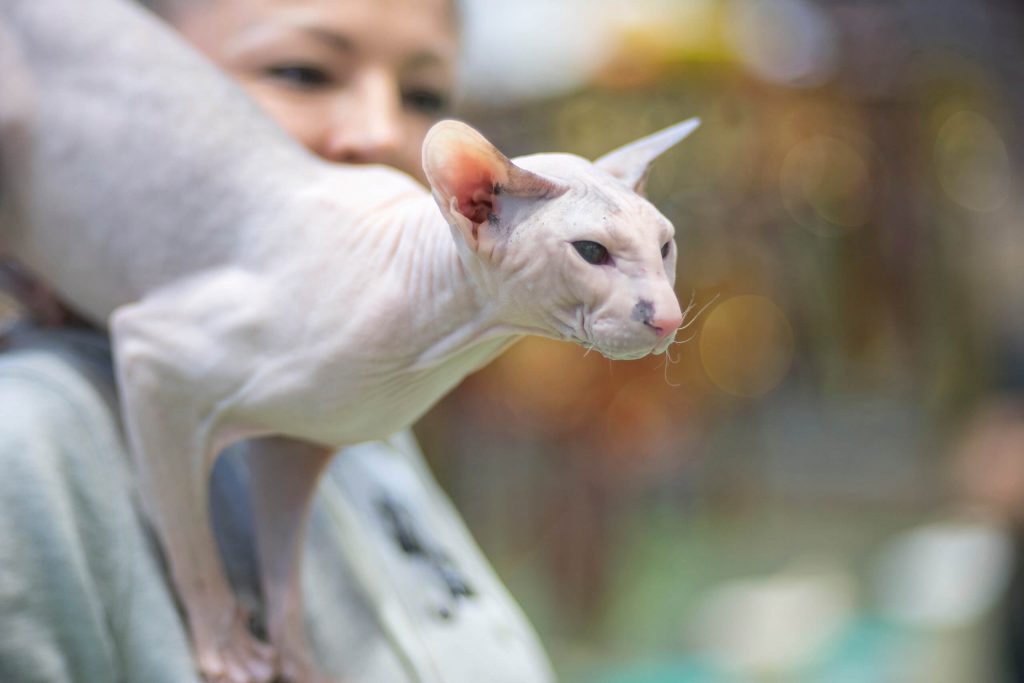
Ukrainian Levkoy
The Ukrainian Levkoy looks a lot like the lop-eared cat known as the Scottish Fold. This is a special feature; along with the folded-back ears of the American Curl. Normally, cats have “open” ears, meaning the ears are wider at the base and set high on the cat’s head; they’re pointed at the end, and they’re hairy. If kittens have inherited the gene for drooping ears, they will be born with erect ears, and after about a month, their ears will begin to fold forward. If you mate a Scottish Fold with a Don Sphynx, the offspring will not only have folded ears, but also very little fur.
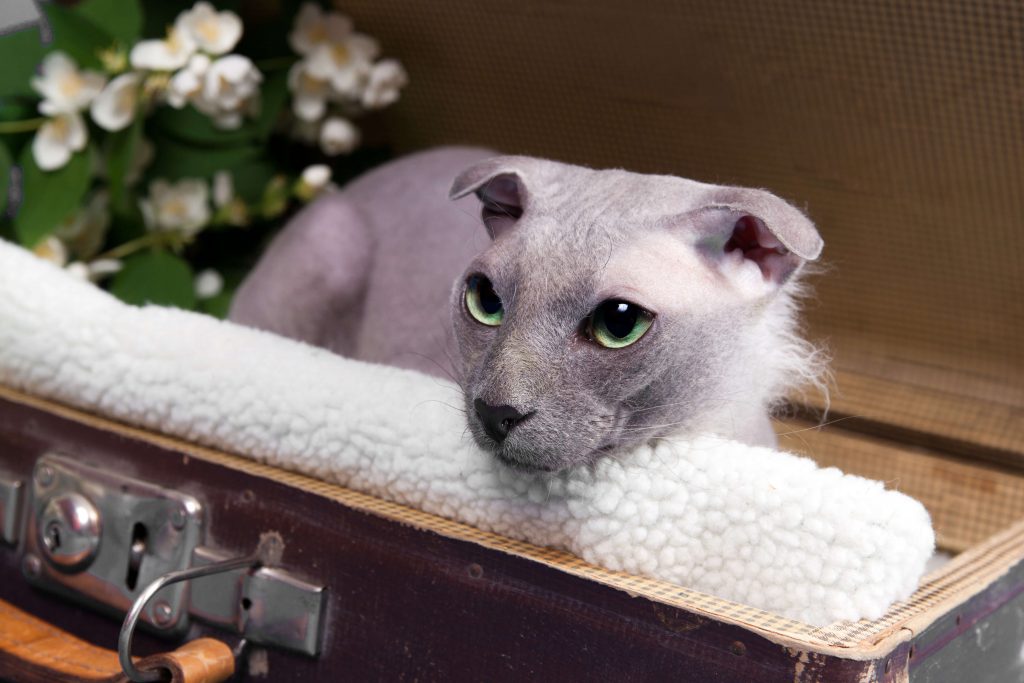
Cats with no fur – are they the perfect cats for allergy sufferers?

Are cats with no fur suitable pets for people who are prone to allergies? People often talk of being “allergic to cat hair”. But cat hair is not what causes the allergy! It only indirectly contributes to those characteristic sniffles and red eyes. A cat allergy is triggered by allergens. Your cat produces these proteins in their anal glands, sebaceous glands and salivary glands. And when your cat grooms itself and licks its coat, it spreads the allergens via its saliva and dander in its environment. This is because saliva sticks to the fur, and it’s the saliva that contains the trigger for the allergy, known as the allergen. A cat with no fur can minimise the severity of an allergic reaction, but the lack of fur won’t completely prevent it.
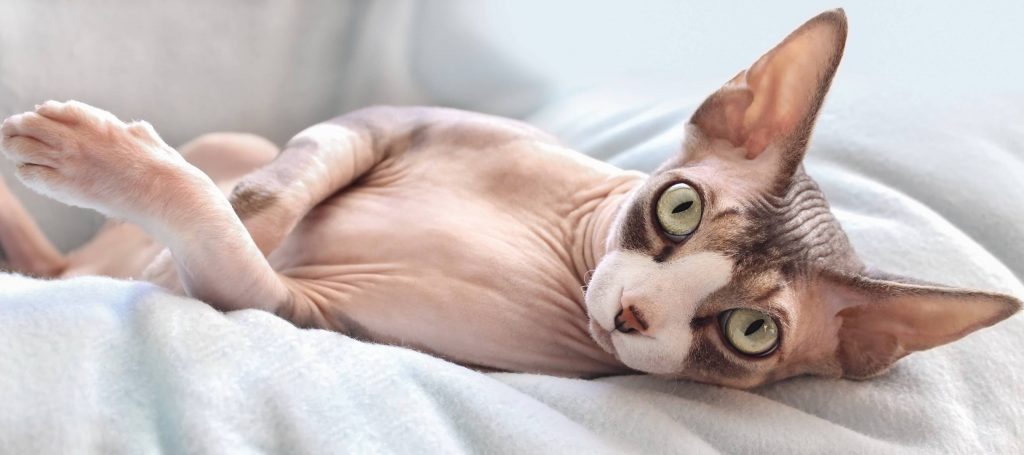
Buying a hairless cat – what you should look out for!
What are the things you should look out for when buying a hairless cat? Before buying any cat, you should ask yourself whether you’re willing and able to meet its specific requirements. Always look for a reputable breeder before you buy a cat. And don’t forget that if a cat doesn’t have any whiskers, they’ll be considered a “torture breed” (Qualzucht), which means that breeding and selling them is illegal in Germany. You can also always inquire at your local animal welfare service³ or animal shelter. Every now and then you might find a hairless cat looking for a new home!
³Source: Pedigree cats and cat-compatible dogs from animal welfare (2024): “Katzen, aber auch katzenfeundliche Hunde suchen ein Zuhause”, online at Pedigree cats and cat-compatible dogs from animal welfare – Cats, but also cat-friendly dogs are looking for a home (rassekatzen-im-tierheim.de), accessed on 6 March 2024.
FAQs – Naked cats
Hairless cats won’t freeze indoors, although they will have to expend more energy to maintain their body
temperature. But they definitely shouldn’t be allowed outside in frosty temperatures without clothing to protect them from the cold.
Cats with no fur were originally a chance find. In fact, hairless cats come from different countries and were not bred at the same time. Still, all hairless cats have one thing in common: a genetic mutation that was once a whim of nature has now established itself as a breed characteristic.
To prevent skin problems, hairless cats should be bathed twice a month. As a matter of fact, when they come from the breeder, these pedigree cats are often already used to being bathed. If your hairless cat has accumulated only a little bit of oil on its skin, it’s usually enough just to wipe them with a warm and damp microfiber cloth.
Hairless cats can live for 15 to 20 years. Whether they age slowly or quickly depends on their genetic predisposition and a number of external factors. With age, their body will change and they’ll find everything increasingly difficult.
The price for a hairless cat can vary. Anyone who buys a pedigree cat can expect it to have the special features and character traits that distinguish these pedigree cats. However, prices can vary greatly depending on the breeder and the specific breed of hairless cat.
Hairless cats should not be kept alone as only cats. They will always want to have other cats around them. But remember that hairless cats have very strong personalities! In other words, the cat you choose as a playmate for them should be on an equal intellectual level. If the second cat is not up to the task, it might end up playing second fiddle to the hairless cat.
Hairless cats are more sensitive to cold than their furred counterparts. In the winter months, a hairless cat should be kept in a well-heated living space. In the summer months, you should always make sure not to expose a hairless cat to direct sunlight without some kind of protection.
Germany’s Animal Welfare Act defines the practice of “Qualzucht” – literally “torture breeding” – as the breeding of animals in a way that fosters or tolerates characteristics that cause them pain, suffering, damage or disorders in their offspring. In Germany, cats with no whiskers are considered a “torture breed”.
A hairless cat can minimise the degree of a person’s allergic reaction, but unfortunately not prevent it completely. Cat allergies are triggered by allergens produced in a number of the cat’s glands, and these proteins are distributed via the cat’s saliva and dander.
